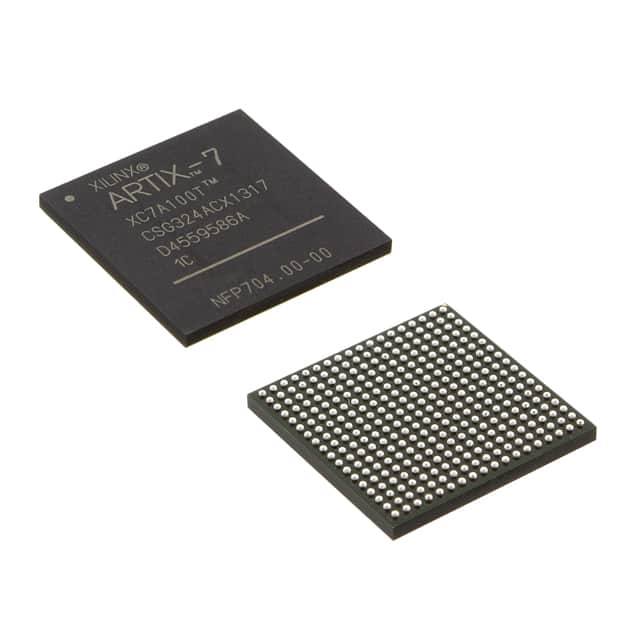XC7A100T-1CSG324C
Product Overview
Category
The XC7A100T-1CSG324C belongs to the category of Field Programmable Gate Arrays (FPGAs).
Use
FPGAs are integrated circuits that can be programmed and reprogrammed to perform various digital functions. The XC7A100T-1CSG324C is specifically designed for high-performance applications.
Characteristics
- High processing power
- Flexible and reconfigurable design
- Low power consumption
- High-speed data transfer capabilities
Package
The XC7A100T-1CSG324C comes in a compact 324-ball grid array (BGA) package.
Essence
The essence of the XC7A100T-1CSG324C lies in its ability to provide customizable digital logic functions, allowing designers to implement complex systems on a single chip.
Packaging/Quantity
The XC7A100T-1CSG324C is typically sold in reels or trays, with each reel containing a specific quantity of chips. The exact packaging and quantity may vary depending on the supplier.
Specifications
- FPGA Family: Artix-7
- Logic Cells: 101,440
- Look-Up Tables (LUTs): 63,400
- Flip-Flops: 126,800
- Block RAM: 4,860 Kbits
- DSP Slices: 240
- Maximum Operating Frequency: 450 MHz
- I/O Pins: 210
- Voltage Range: 0.95V - 1.05V
Detailed Pin Configuration
The XC7A100T-1CSG324C has a total of 324 pins, each serving a specific purpose. The pin configuration includes input/output pins, power supply pins, clock pins, and configuration pins. For a detailed pin configuration diagram, please refer to the datasheet provided by the manufacturer.
Functional Features
- High-speed serial connectivity
- Integrated memory blocks for efficient data storage
- Advanced DSP capabilities for signal processing
- Configurable I/O standards for versatile interfacing options
- On-chip analog-to-digital converters (ADCs) for sensor integration
Advantages and Disadvantages
Advantages
- Flexibility: FPGAs offer the ability to reconfigure hardware, allowing for rapid prototyping and design iterations.
- High Performance: The XC7A100T-1CSG324C provides a high level of processing power and can handle complex algorithms efficiently.
- Low Power Consumption: Compared to traditional application-specific integrated circuits (ASICs), FPGAs consume less power.
- Scalability: FPGAs can be easily scaled up or down depending on the requirements of the application.
Disadvantages
- Complexity: Designing with FPGAs requires specialized knowledge and expertise.
- Cost: FPGAs can be more expensive than other types of integrated circuits, especially for large-scale production.
- Limited Resources: The available resources within an FPGA, such as logic cells and memory, may impose constraints on the complexity of the design.
Working Principles
FPGAs consist of an array of configurable logic blocks (CLBs) interconnected through programmable routing channels. The XC7A100T-1CSG324C utilizes look-up tables (LUTs) to implement digital logic functions and flip-flops to store intermediate values. These components can be programmed using a hardware description language (HDL) to define the desired functionality. During operation, the FPGA executes the programmed logic, enabling the system to perform the intended tasks.
Detailed Application Field Plans
The XC7A100T-1CSG324C finds applications in various fields, including:
- Communications: FPGAs are used in wireless communication systems, network routers, and base stations to handle high-speed data processing and protocol implementation.
- Industrial Automation: FPGAs enable real-time control and monitoring in industrial automation systems, such as robotics, machine vision, and process control.
- Aerospace and Defense: FPGAs are utilized in radar systems, avionics, and military-grade communication equipment for their high performance, reliability, and reconfigurability.
- Medical Devices: FPGAs play a crucial role in medical imaging, patient monitoring, and diagnostic equipment by providing fast and accurate data processing capabilities.
- Automotive: FPGAs are employed in advanced driver-assistance systems (ADAS), infotainment systems, and engine control units (ECUs) to enhance vehicle safety and performance.
Detailed and Complete Alternative Models
- XC7A200T-1CSG324C: A higher-capacity FPGA from the same Artix-7 family, offering increased logic cells and memory resources.
- XC7K160T-1FBG676I: A member of the Kintex-7 FPGA family,
Lista 10 Vanliga frågor och svar relaterade till tillämpningen av XC7A100T-1CSG324C i tekniska lösningar
Sure! Here are 10 common questions and answers related to the application of XC7A100T-1CSG324C in technical solutions:
Q1: What is XC7A100T-1CSG324C? A1: XC7A100T-1CSG324C is a field-programmable gate array (FPGA) from Xilinx. It is part of the Artix-7 family and has 101,440 logic cells.
Q2: What are the key features of XC7A100T-1CSG324C? A2: Some key features of XC7A100T-1CSG324C include high-performance programmable logic, integrated memory blocks, DSP slices, and multiple I/O standards.
Q3: What are the typical applications of XC7A100T-1CSG324C? A3: XC7A100T-1CSG324C can be used in various applications such as industrial automation, aerospace and defense systems, automotive electronics, telecommunications, and high-performance computing.
Q4: How does XC7A100T-1CSG324C benefit industrial automation? A4: XC7A100T-1CSG324C offers high-speed processing capabilities, real-time control, and flexibility, making it suitable for tasks like motor control, machine vision, and process monitoring in industrial automation.
Q5: Can XC7A100T-1CSG324C be used in automotive electronics? A5: Yes, XC7A100T-1CSG324C can be used in automotive electronics for applications like advanced driver-assistance systems (ADAS), infotainment systems, and engine control units (ECUs).
Q6: How does XC7A100T-1CSG324C support high-performance computing? A6: XC7A100T-1CSG324C provides high-speed data processing, parallel computing capabilities, and efficient memory utilization, making it suitable for applications in scientific research, data centers, and supercomputing.
Q7: Can XC7A100T-1CSG324C be used in telecommunications? A7: Yes, XC7A100T-1CSG324C can be used in telecommunications for tasks like signal processing, protocol conversion, network packet processing, and baseband processing in wireless communication systems.
Q8: What are the advantages of using XC7A100T-1CSG324C in aerospace and defense systems? A8: XC7A100T-1CSG324C offers radiation tolerance, high reliability, and the ability to implement complex algorithms, making it suitable for applications in satellite systems, avionics, radar systems, and secure communications.
Q9: How does XC7A100T-1CSG324C support image and video processing? A9: XC7A100T-1CSG324C has dedicated digital signal processing (DSP) slices that can accelerate image and video processing algorithms, enabling tasks like image recognition, video compression, and real-time video analytics.
Q10: Can XC7A100T-1CSG324C be used in Internet of Things (IoT) applications? A10: Yes, XC7A100T-1CSG324C can be used in IoT applications for tasks like sensor data processing, edge computing, and connectivity protocols, enabling smart home automation, industrial IoT, and wearable devices.
Please note that these answers are general and may vary depending on specific requirements and implementation details.


